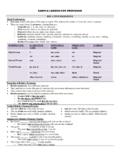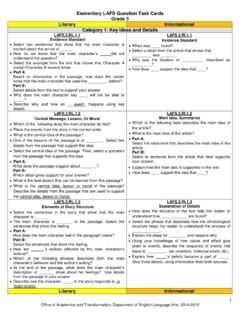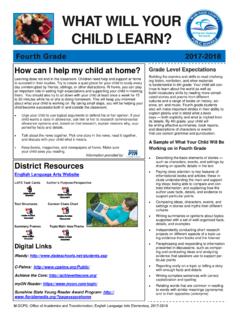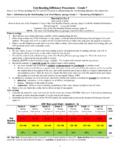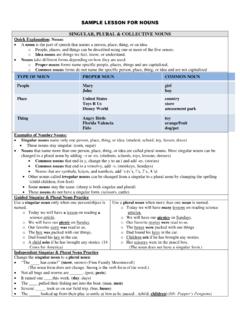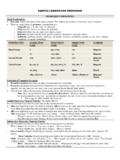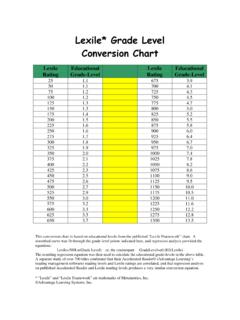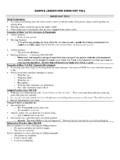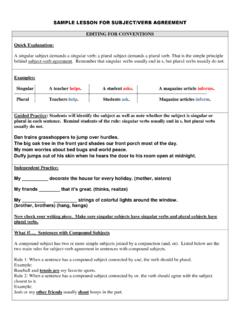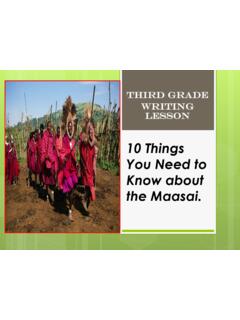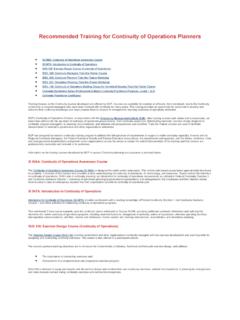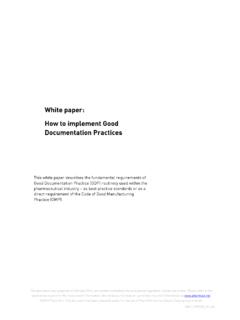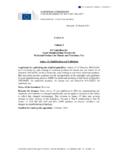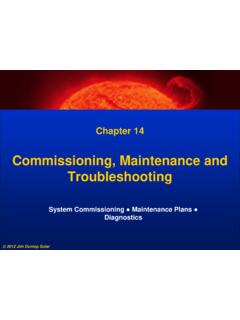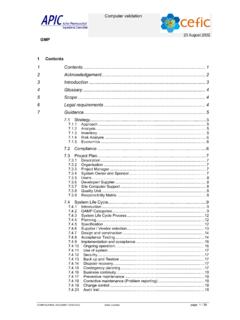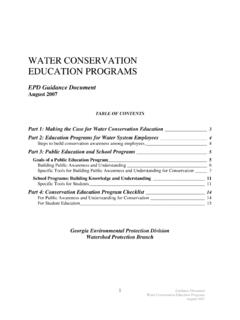Transcription of Reflective Coaching Conversations: A Missing Piece
1 Reflective Coaching Conversations: A Missing Piece Debra S. Peterson, Barbara M. Taylor, Bobbie Burnham, Rynell Schock Examining real-life literacy Coaching reasons for this are that the use of literacy coaches for schoolwide reading improvement and profession- interactions can provide insight on the al development is a fairly new phenomenon, there elements of Coaching conversations is little uniformity in the role of coaches from site to that are the most effective in fostering site, there is a lack of data linking Coaching directly to changes in teacher practice and student achieve- teachers' reflection on their instruction ment, and there is limited documentation of what ac- and on students' reading and learning. tually occurs during Coaching interactions. Deussen, Coskie, Robinson, and Autio (2007) found that the L. role of the literacy coach looked very different from iteracy Coaching is a critical component of school to school and covered a variety of responsi- many major schoolwide reading improvement bilities other than Coaching .
2 They stated, Simply efforts in our nation today. Under Reading First knowing that literacy coaches are in schools does alone, more than 5,600 schools have hired full-time not imply anything about how those individuals are literacy coaches as a way to provide job-embedded spending their time there is a difference between learning for teachers (Moss, Jacob, Boulay, Horst, being a coach and doing Coaching (p. iii). When sur- & Poulos, 2006). Many authors and current publica- veyed, coaches reported that many non-instructional tions promote the use of literacy coaches for profes- tasks overshadowed their work with teachers and sional development and reading reform. Neufeld and students. Roper (2003) wrote, When Coaching is integral to For example, in a study by Bean and Zigmond a larger instructional improvement plan that targets (2006), 100 coaches in 161 Reading First schools and aligns professional development resources to- documented how they used their time by completing ward the district's goals, it has potential to become a weekly log three times during the year.
3 Coaches a powerful vehicle for improving instruction and, reported that they spent less than 3 hours a week thereby, student achievement (p. 26). Joyce and in each of the following: observations ( hours), Showers (1995) stated that teachers need to have op- Coaching conferences with teachers ( hours), portunities to learn about new strategies and tech- modeling ( hours), and coteaching ( hours). niques, to observe demonstration of strategies, and The coaches also documented more than 4 hours a to practice and receive feedback on the strategies in week devoted to each of these noninstructional ac- their own classroom setting. Uzat (1998) considered tivities: attending meetings ( hours), planning ( Coaching a practical and systematic approach to on- hours), and attending professional development ses- going teacher improvement by engaging teachers in sions ( hours). Clearly, Coaching activities account- focused reflection on teaching methods. ed for only a fraction of time during coaches' work As compelling as these recommendations may weeks.
4 When literacy coaches do work with teachers seem, there is little empirical evidence that hav- in a Coaching capacity, there is little documentation ing literacy coaches in schools leads to growth of what they do, how the Coaching affects teacher and achievement in students' reading. Some of the performance, and ultimately how the Coaching of The Reading Teacher, 62(6), pp. 500 509 2009 International Reading Association 500 ISSN: 0034-0561 print / 1936-2714 online teachers stimulates students' growth and achieve- that don't work as well as they could, and abandon ment in reading. practices that seem to hinder what works. (p. 13). The purpose of this article is to document and describe actual Coaching conversations between lit- In this model of Coaching , a critical component of eracy coaches and teachers in elementary schools Coaching conversations was the use of concrete data that were seeing important gains in students' reading on the teacher's instruction to facilitate self-reflection and change.
5 This critical component is often the achievement. Examining real-life Coaching interac- Missing Piece to reading reform efforts. tions may provide insight on the elements of coach- ing conversations that are more effective in fostering teachers' reflection on the impact of their instruction Background of the Study on students' reading and learning. These examples The 24 schools involved in the Minnesota Reading may contribute to our understanding of how to help First Professional Development Program (Taylor &. teachers modify instruction to increase its effective- Peterson, 2007) were diverse in location ( , inner- ness and to sustain these practices in their daily city, suburban, small town, rural), socioeconomic sta- teaching of reading. Perhaps these examples will also tus (32% 95% of their students received subsidized inspire schools that do not foster teacher reflection to lunches), and percent of students who were English- consider the importance of establishing a climate of language learners (ELLs; 0% 66%).
6 As a part of their continual learning and collaboration as a means to ongoing, job-embedded professional development reading reform. all kindergarten to grade 3 classroom teachers and With the Coaching conversation model used in the licensed resource teachers in a school participated Minnesota Reading First Professional Development in weekly, teacher-led, collaborative study groups Program, a literacy coach observed a teacher's read- to discuss scientifically based reading research, to ing lesson and collected data on the observed in- learn new instructional techniques and to refine their struction. These data may have included a count of current practices, to examine student data and to ad- the number of students that were on task at various just daily instruction based on students' progress or times throughout the lesson, information on teacher needs. student interaction patterns and the use of grouping Teachers also shared video clips of their own patterns or materials, as well as concrete examples of instruction in their study groups to gain suggestions other critical elements of instruction during a specific and insights from their colleagues and to facilitate lesson ( , higher order questions, comprehension self-reflection.)
7 To assist teachers in this process of strategy instruction). The coach then used these data learning and reflection, each school had two literacy to ask questions to support the teacher in a process coaches, one full-time coach provided by the school of self-reflection and conversation about her teach- district and one half-time coach provided by the ing practices and students' reading performance. professional development provider, the University of Coaching for self-reflection is a collaborative Minnesota. Coaches were encouraged to work as a model in which the coach and the teacher work in team to support the school in its efforts to implement partnership to make more effective decisions about schoolwide instructional reading improvement in classroom instruction. The ultimate goal of work- kindergarten to grade 3. Coaches had many respon- ing with a literacy coach is to deepen the teacher's sibilities in their schools but were encouraged to understanding of how students learn by facilitating spend 80% of their time in classrooms working with self-reflection to bring about change in classroom teachers on reading instruction.
8 Instruction, which has the potential to lead to in- The 48 Minnesota Reading First coaches were creased student achievement. Rodgers and Rodgers a diverse group of teachers. They ranged in experi- (2007) wrote, ence from 5 to 30 or more years in teaching, and their educational backgrounds ranged from Bachelor to By supporting and fostering conversations about teach- Doctorate degrees. Some of the coaches had admin- coach has the opportunity to provoke not only deep reflection but also action regarding teaching. istrative or mentoring experience but the majority of Through careful analysis, teachers have an opportu- coaches had left regular education classroom teach- nity to enhance practices that work, reform practices ing assignments to serve as literacy coaches in the Reflective Coaching Conversations: A Missing Piece 501. Reading First schools. During 2006 2007, all but one orally responding with a partner) versus passive of the coaches were female. responding ( , listening, reading turn-taking, oral turn-taking) during this reading lesson?
9 O what extent did I clearly identify and ex- T. Training for Coaches n plain the purpose of the lesson? How will my Literacy coaches met approximately ever y five lesson help individual students grow in literacy weeks to engage in professional learning on scien- abilities? tifically based reading research on the five main ar- eas of reading as described by the National Reading Coaches also received training on elements of ef- Panel Report (National Institute of Child Health and fective instruction not specifically addressed in the Human Development [NICHD], 2000) including National Reading Panel Report including motivation, phonemic awareness, phonics and the application culturally responsive instruction, and differentiation of word recognition strategies, fluency, vocabulary, of instruction based on student assessment data. The and comprehension. The professional development emphasis of the training was to consider ways to pro- also provided time for coaches to reflect on and re- vide challenge and rigor for all students.
10 Fine their ability to facilitate Coaching conversations with teachers at their sites. Included in these profes- sional development sessions were opportunities to Selection of Schools view video clips of each other's teaching and then for Further Study initiate Coaching conversations with one another. A. We wanted to capture and describe Coaching con- third coach was encouraged to observe the Coaching versations that were occurring in the Minnesota conversation so that he or she could provide feed- Reading First schools by observing some effective back to the coach. Coaching teams during a normal school day. We se- Coaches also learned to use several protocols lected Coaching teams based on three criteria: over- designed to collect data on instruction as the basis all school effectiveness rating, overall school reform for their subsequent Coaching conversations with effort rating, and students' growth in reading. Each of teachers. All of the protocols were based on current these will be described below: research on effective reading instruction and a mod- el of reading instruction that maximizes students' 1.
